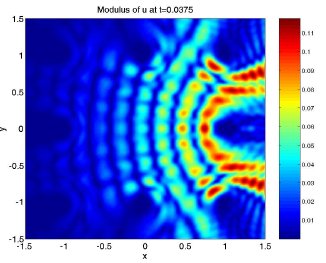Numerical Solution of Periodic Media Problems
joint work with
C. Zheng, Tsinghua University, Beijing, China
H. Han, Tsinghua University, Beijing, China
J. Sun, Delaware State University, Dover, USA
 
| |
Summary
Periodic structure problems often arise in science and
engineering and often they are modeled by partial differential
equations (PDEs) with periodic coefficients and/or periodic geometries.
Periodic structure problems exist in modern applications of
semiconductor nanostructures (e.g.\ quantum dots and nanocrystals),
semiconductor superlattices,
photonic crystal structures, meta materials with negative refractive indices
or Bragg gratings of surface plasmon polariton wave guides.
In order to numerically solve these equations efficiently one usually
confines the spatial domain to a bounded computational domain (in a
neighborhood of the region of physical interest).
The usual strategy is to introduce so-called artificial boundaries
and impose adequate boundary conditions [1].
For wave-like equations, the ideal
boundary conditions should not only lead to well-posed problems,
but also mimic the perfect absorption of waves traveling out of the
computational domain through the artificial boundaries.
First we present a novel
analytical impedance expression is presented for general second
order ODE problems with periodic coefficients [2]
and its validity is shown to be strongly supported by numerical evidences.
This new expression for the kernel of the Dirichlet-to-Neumann mapping of the
artificial boundary conditions is then used for computing the bound
states of the Schrödinger operator with periodic potentials at
infinity using an 8th order finite element method.
Other potential applications are associated with the exact
artificial boundary conditions for some
time-dependent problems with periodic structures.
As an example, a two-dimensional hyperbolic equation modeling
the TM polarization of the electromagnetic field with
a periodic dielectric permittivity is considered.
Secondly we design a new numerical technique for solving
periodic structure problems [3].
This novel approach possesses several advantages.
First, it allows for a fast evaluation of the Robin-to-Robin
operator for periodic array problems.
Secondly, this computational method can also be used for
bi-periodic structure problems with local defects.
Our strategy is an improvement of the recently developed
recursive doubling process by Yuan and Lu.
We will consider several problems,
such as the exterior elliptic problems with strong coercivity,
the time-dependent Schrödinger equation
and finally the Helmholtz equation with damping and solve them with an
8th order finite element method.
Let us note that the critical case when the wavenumber lies in the passbands is
discussed concisely in [4].
Application Partners
References
- X. Antoine, A. Arnold, C. Besse, M. Ehrhardt and A. Schädle,
A Review of Transparent and Artificial Boundary Conditions Techniques for Linear and Nonlinear Schrödinger Equations,
Commun. Comput. Phys. 4 (2008), 729-796. (open-access article)
supplementary material (Matlab codes):
- M. Ehrhardt and C. Zheng,
Exact artificial boundary conditions for problems with periodic structures,
J. Comput. Phys. 227 (2008), 6877-6894.
- M. Ehrhardt, H. Han and C. Zheng,
Numerical simulation of waves in periodic structures,
Commun. Comput. Phys. 5 (2009), 849-870.
- M. Ehrhardt, J. Sun and C. Zheng,
Evaluation of scattering operators for semi-infinite periodic arrays,
Commun. Math. Sci. 7 (2009), 347-364.
- M. Ehrhardt (ed.),
Wave Propagation in Periodic Media - Analysis, Numerical Techniques and practical Applications,
Progress in Computational Physics 1, Bentham Science Publishers Ltd., 2010.
- M. Ehrhardt and C. Zheng,
Fast numerical methods for the simulation of waves in periodic structures,
Chapter 7 in: M. Ehrhardt (ed.),
Wave Propagation in Periodic Media - Analysis, Numerical Techniques and practical Applications,
Progress in Computational Physics 1, Bentham Science Publishers Ltd., 2010, pp. 135-166.





